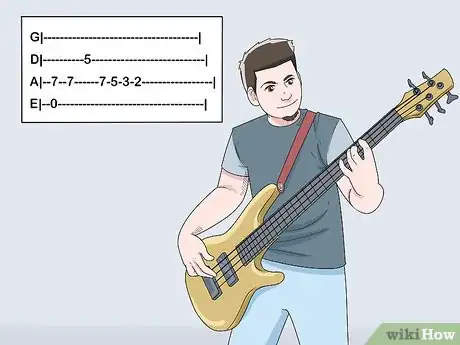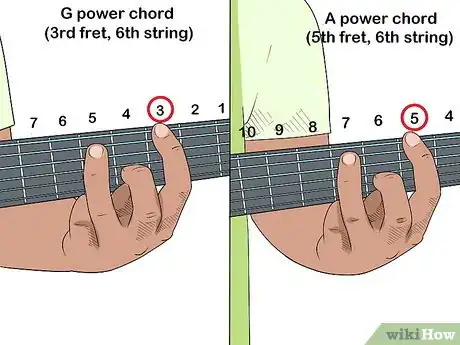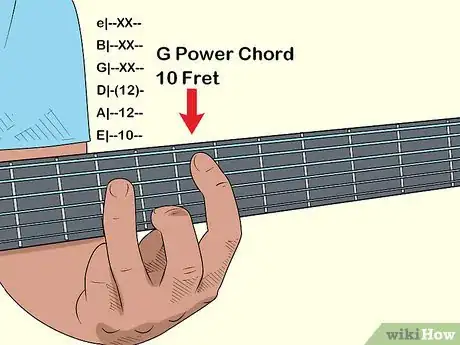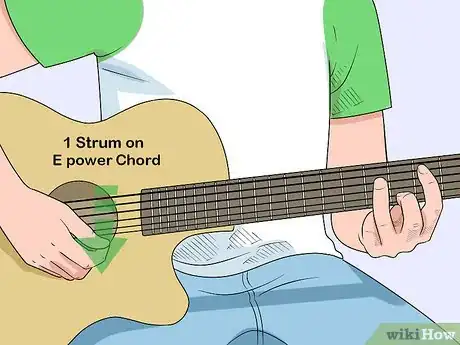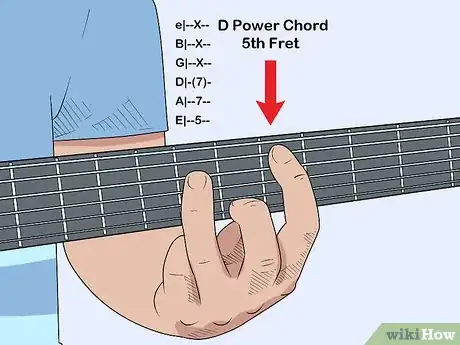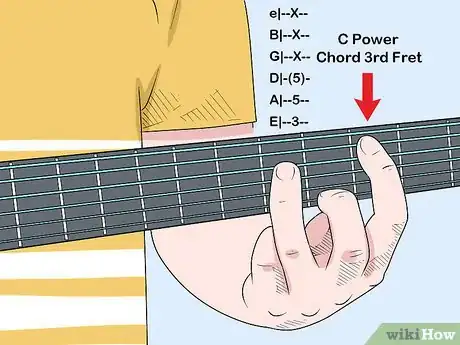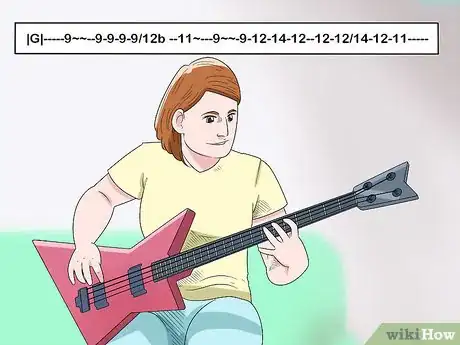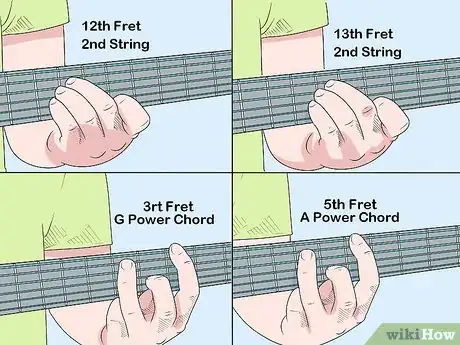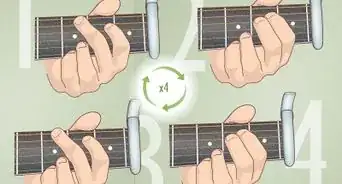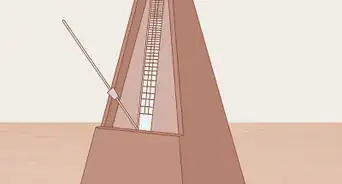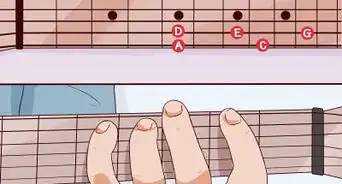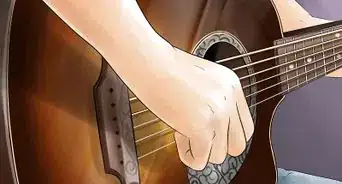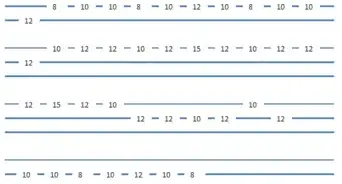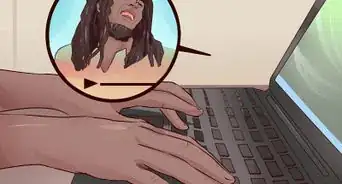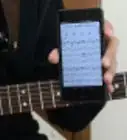This article was co-authored by wikiHow Staff. Our trained team of editors and researchers validate articles for accuracy and comprehensiveness. wikiHow's Content Management Team carefully monitors the work from our editorial staff to ensure that each article is backed by trusted research and meets our high quality standards.
This article has been viewed 210,823 times.
Learn more...
"Seven Nation Army" is a popular rock song by the band The White Stripes. After being covered by pop artist Martin Collins, nearly everyone knows a version of "Seven Nation Army." Playing this song to family and friends is always going to get a reaction and might even inspire a few people to sing along.
Steps
Learning the Key Riff (Verse)
-
1Learn the bass note riff at the centre of the song to guide your playing. This is the iconic set of notes that the song begins with, played on the bass. The exact same riff is repeated through the verse and chorus, though Jack White plays the notes as power chords on the guitar. If you can learn the basic riff, however, you can add the chords in later with ease. The bass riff looks like:
- G|-------------------------------------|
D|----------5---------------------------|
A|--7--7------7-5-3-2-----------------|
E|--0-----------------------------------| - In the real song, this is only a bass guitar riff. But you can crank up the distortion or use an octave pedal to mimic the sound on an electric guitar.
- G|-------------------------------------|
-
2Use your index finger, sliding it around the neck, as much as possible. Get used to moving your whole hand fluidly across the guitar to master the above riff. Use your index finger to fret as much as possible instead of switching fingers -- you'll need your ring and pinkie free to make chords later on.
- Listen closely and you can hear Jack White sliding around the guitar. It is most pronounced right before he launches into the riff, sliding into that 7th fret note.
Advertisement -
3Learn the implied guitar chords for the verse. If you were to play the song with just an acoustic guitar, for example, you'd need to know the chord melodies. But these chords could be used for any cover or version -- look at Marcus Collins version, which uses rhythm guitar in the verse where the original has none. To play chord melodies, simply play the following chords -- each chord times up to the same note in the bass riff above.
- E (7th fret, 5th string)
- G (5th fret, 4th string)
- D (5th fret, 5th string)
- C (3rd fret, 5th string
- B (2nd fret, 5th string
- These can be played as straight chords or powerchords.[1]
-
4Fix up your amp. To get a real "White Stripes" sound from your guitar, your amp needs to be adjusted a little. Don't worry, you're not opening anything up, just change the settings a little. You'll need quite a bit of gain, try turning that up to 8. To even that out, keep your treble all the way up to 7 or 8 too. Keeps the mids at 5 while the bass should be pumped up to 8. If your amp has an effect called "Presence", turn that up to 8 too.
Nailing the Chorus
-
1Review you power chords if you've never used them. Power chords are simple 2-finger chords used for big, brash, and quick songs. If you've never made them, they are actually easy to build. Start with your index finger on any fret on the top two strings -- use the first note of the Seven Nation Army riff (7th fret, 5th string) to start. Now, simply place your ring finger one string and two frets down, on the 9th fret, 4th string. Only play these two strings -- this is your power chord
- For even bigger, better chords, add your pinky on the string and fret below your ring finger (9th fret, 3rd string), so your final chord has three notes.
- The note your index finger is on determines the chord. Since the note in the example is an E, this is an E power chord.
-
2Learn the two-chord bridge into the chorus. This is the section that begins with the words (in the first verse, at least) "and the message in my eyes..." As he says this you should:
- Hit a G power chord (3rd fret, 6th string) for one full measure.
- Switch to an A power chord (5th fret, 6th string) or an open A (2nd fret, 2nd-4th strings) for one full measure.
-
3Start the chorus with two strums of an E power chord. You want to start with one big strum, followed up by a shorter one. In case you've forgotten, an E power chord looks like this:
- e|--X--
- B|--X--
- G|--X--
- D|-(9)-
- A|--9--
- E|--7--
-
4Slide your whole power chord down to the 10th fret to play a G. You want to practice keeping the same finger shape together as you move across the neck, since power chords all of the same shape. After the second, quicker strum, jump quickly up to the 10th fret and strum it once. This chord takes the place of the 5th fret, 3rd string shown in the bass riff above.
- e|--XX--
- B|--XX--
- G|--XX--
- D|-(12)-
- A|--12--
- E|--10--
-
5Slide right back to the E chord for one quick strum. From here on out, you'll be repeating the bass riff, just with power chords. Hit the E one more time on you way back up the guitar.
-
6Hit the 5th fret, D power chord as you slide back up the neck. Your next chord is another power chord, the 5th fret on the 5th string.
- e|--X--
- B|--X--
- G|--X--
- D|-(7)-
- A|--7--
- E|--5--
-
7Keep moving to the 3rd fret power chord. Keep on following the bass riff. The chord is still the same shape. This is a C power cord, sometimes called a C5.
- e|--X--
- B|--X--
- G|--X--
- D|-(5)-
- A|--5--
- E|--3--
-
8Land the last power chord on the 2nd fret, then repeat the entire thing. The last chord is the B and is located on the 2nd fret of the 5th string. Once you've hit this, there is a brief pause before you simply repeat the chords once more for the chorus.
- e|--X--
- B|--X--
- G|--X--
- D|-(4)-
- A|--4--
- E|--2--
-
9Listen to the song repeatedly to learn the rhythm and order of the song. "Seven Nation Army" is simple, and doesn't have any vigorous strumming. After learning all of the power chords, you need to learn the actual song. There are three parts: a verse, a chorus, and a bridge. Listen to the song to see how the music changes during these parts.
- The Verse is only bass and drums. You can, however, play the chords of the song, or play the bass riff on guitar.
- The bridge is simply your way in and out of the chorus. At the end of the verse, right before jumping into the power chords, play the two chord bridge. You also play it after the chorus, right before going into the verse again.
- The chorus is your power chord riff. This exact same riff is also played behind the guitar solo.
Hitting the Solo
-
1Internalize the rhythm from the bass guitar, as it is the same one used in the solo. The guitar solo in "Seven Nation Army" isn't technically difficult. But rhythmically it is almost in perfect tune with the iconic bass riff from the beginning of the song. This this powerful, plodding, and deliberate rhythm is key to making the solo sound nice.
- If you need, review and learn the bass line before the solo. It is easy enough and will help immensely.
- All you're doing is taking the following sets of notes, and putting them through the same rhythm as the bass solo.
- Start part one of the solo on the 9th fret, 3rd string. The solo has two parts -- both of which follow the style of the bass riff. The first half starts on the 9th string, playing the 9th string repeatedly in place of the held root note in the bass riff. After leaving the 9th, keep playing the rest of the notes as if they were the bass guitar. Play this riff twice.
- |G|-----9~~--9-9-9-9/12b--11~---9~~-9-12-14-12--12-12/14-12-11-----
-
2Move down to the 12th fret on the 1st string to kick the solo up a notch. This riff is when the guitar really starts to squeal. Keep practising, playing along with the song, to get the feel for the bends. Note, as well, how much vibrato (when you "shake" a note, as indicated by the "~") is used to give the notes flavor and attitude.
- |e|-----12--12-15-12-12-15b--14~~----12--12-15-17-15--15-15/17-15-14~~-----
-
3Replay the last section, avoiding the high-pitched notes on the 17th fret, to end the solo. The last little section of the song sounds great if you play the B-string occasionally as well, barring both strings on the same fret. This can add some of the body and power to your solo as you're playing, helping you capture some of the attitude of the original.
- |e|-----12--12-14-12-12-15b-15~~----12--12-14-12-12-14-12.
-
4Use the bridge chords as your outro. Once the solo is over, quickly play the 13th and 12th frets on the B-string (2nd string). Then jump into a quiet rendition of your bridge -- the G and A power chords-- to transition back into the verse.
- If you know how, palm mute these last two chords for the best effect.[2]
References
About This Article
The song “Seven Nation Army” is a great choice if you want to play something on guitar for your friends or family. To play the main riff, you’ll start on “G,” followed by the 5th fret on “D,” the 7th fret on “A” 3 times, the 5th fret on “A,” the 3rd fret on “A,” the 2nd fret on “A,” and an open “E.” Turn your bass up to 8, and increase your “presence” setting to 8 as well if your amp has it. When you transition to the chorus, you’ll need to play a “G” power chord followed by an “A” power chord. The chorus begins with an “E” power chord, which you should strum twice. Then, slide down to the 10th fret for a “G” power chord. After this, follow the same pattern for the riff but with power chords for the rest of the chorus. For tips on how to play the guitar solo in the song, keep reading!
